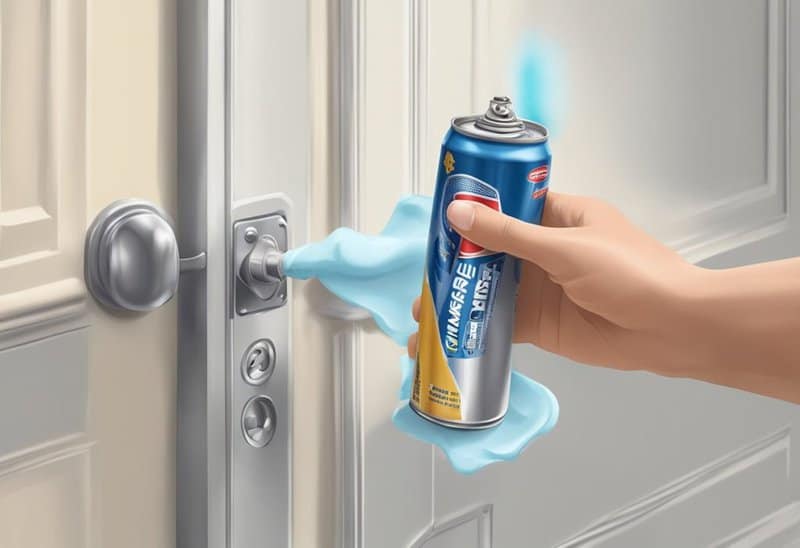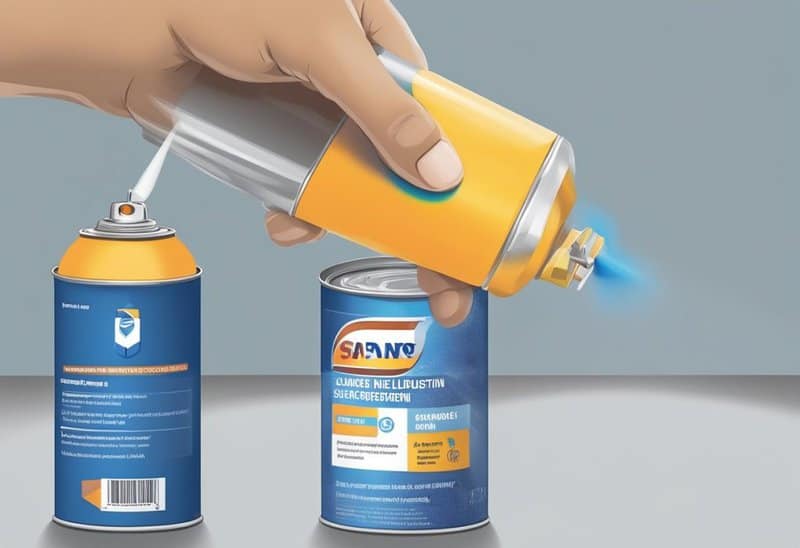Silicone spray is a versatile product that can be used for a variety of applications. It is a lubricant that can be used on metal, wood, rubber, plastic, and other surfaces. The spray is made up of silicone oil that is super slippery and minimally-reactive, making it an excellent lubricant for most anything.

One of the main uses of silicone spray is as a lubricant for noisy door hinges. It can also be used on car handles and hinges to protect against freezing or sprayed in a car’s engine to prevent rust. Additionally, it can be used in the home to lubricate sliding doors, windows, and drawers. Silicone spray can even be used as a tire sealant to prevent flats and improve tire performance.
Another use of silicone spray is in waterproofing. It can be sprayed on paper, ceramics, and other materials to make them waterproof. It can also be used to protect outdoor furniture, grills, and other metal objects from rust and corrosion. Silicone spray is also used in the aerospace industry to protect airplanes from corrosion and as a heat-resistant insulator.
Overall, silicone spray is a useful product that can be used for a variety of applications. Its versatility makes it a popular choice for homeowners, mechanics, and professionals alike.
Overview of Silicone Spray
Silicone spray is a versatile lubricant that can be used for a wide range of applications. It is a clear, odorless liquid that is made from silicone, a synthetic compound that is known for its excellent lubricating properties. In this section, we will take a closer look at the composition and properties of silicone spray, as well as the benefits of using it.
Composition and Properties
Silicone spray is made from a combination of silicone oil and a carrier solvent. The silicone oil provides the lubricating properties, while the carrier solvent helps to distribute the silicone oil evenly over the surface being lubricated. The carrier solvent also helps to evaporate the silicone oil quickly, leaving behind a clear, odorless film.
Silicone spray is known for its long-lasting lubrication properties. It can withstand a wide range of temperatures and can provide lubrication for extended periods of time without breaking down. It is also non-corrosive and non-reactive, which means it can be used on a wide range of surfaces without causing damage.
Benefits of Using Silicone Spray
There are many benefits to using silicone spray. One of the main benefits is its versatility. It can be used on a wide range of surfaces, including metal, plastic, rubber, and wood. It can also be used for a variety of applications, including lubricating machinery, protecting electrical components, and waterproofing surfaces.
Another benefit of using silicone spray is its clear, odorless formula. This makes it ideal for use in areas where other lubricants may leave behind a residue or an unpleasant odor. It is also non-toxic, which makes it safe for use in food processing and other sensitive applications.
Overall, silicone spray is a reliable and effective lubricant that can be used for a wide range of applications. Its long-lasting lubrication properties, clear and odorless formula, and versatility make it an excellent choice for anyone looking for a high-quality lubricant.
Applications of Silicone Spray
Silicone spray is a versatile lubricant that can be used for a variety of applications. Here are some of the most common uses of silicone spray:
Lubrication for Moving Parts
Silicone spray is an excellent lubricant for moving parts. It can be used on door locks, hinges, linkages, window guides, and bushes. It also preserves and protects rubber moldings, weather strips, grommets, o-rings, rubber seals, dashboards, door moldings, plastic parts, and mountings. It is ideal for lubricating surfaces that may be damaged by conventional lubricants such as grease or oil. Silicone spray reduces friction between moving parts, which helps to extend their lifespan.
Waterproofing and Moisture Protection
Silicone spray is waterproof and can protect against moisture. This makes it ideal for use in outdoor applications. It can be used to waterproof and protect metal, rubber, plastic, wood, glass, leather, vinyl, fabrics, and painted surfaces. Silicone spray creates a barrier that prevents moisture from penetrating the surface, which helps to prevent rust and corrosion.
Corrosion and Rust Prevention
Silicone spray provides excellent corrosion protection. It helps to prevent rust and corrosion on metal surfaces by creating a barrier that prevents moisture and other corrosive substances from penetrating the surface. It can be used to protect metal surfaces such as tools, machinery, and equipment from rust and corrosion.
Surface Treatment and Protection
Silicone spray can be used to treat and protect a variety of surfaces. It can be used to protect and restore the shine of plastic, vinyl, and leather surfaces. It can also be used to protect and restore the shine of painted surfaces. Silicone spray creates a thin film on the surface that protects it from UV rays and other environmental factors that can cause fading and discoloration. It can also be used to protect and restore the shine of wood surfaces.
Overall, silicone spray is a versatile lubricant that can be used for a variety of applications. It is an effective lubricant for moving parts, provides waterproofing and moisture protection, helps prevent corrosion and rust, and can be used to treat and protect a variety of surfaces.
Household Uses of Silicone Spray

Silicone spray is a versatile lubricant that can be used for various household purposes. It is an excellent choice for home maintenance and furniture and fixture care. In this section, we will discuss some of the common household uses of silicone spray.
Home Maintenance
Silicone spray is ideal for home maintenance tasks. It can help to prevent rust and corrosion on metal surfaces, making it perfect for lubricating door hinges, locks, and garage doors. It can also be used to lubricate window tracks, sliding glass doors, and door handle mechanisms.
When using silicone spray for home maintenance, it is essential to apply it sparingly and wipe off any excess. This will prevent the spray from attracting dirt and dust, which can cause the lubrication to wear off quickly.
Furniture and Fixture Care
Silicone spray is also an excellent choice for furniture and fixture care. It can be used to lubricate drawers and hinges, making them easier to open and close. It can also be used to protect wood and metal furniture from moisture and humidity, preventing warping and rusting.
When using silicone spray on furniture, it is important to test it on an inconspicuous area first to ensure that it does not damage the finish. It is also essential to apply it sparingly and wipe off any excess to prevent it from attracting dirt and dust.
In conclusion, silicone spray is a useful household lubricant that can be used for various purposes. It is an excellent choice for home maintenance and furniture and fixture care. When using silicone spray, it is important to apply it sparingly and wipe off any excess to ensure that it does not attract dirt and dust.
Automotive and Industrial Applications

Vehicle Maintenance
Silicone spray is commonly used in automotive applications to lubricate and protect various components. It can be used to lubricate door, hood, and deck-lid or lift-gate hinges and latches, preventing them from squeaking and rusting. Additionally, it can be used to lubricate cables, pulleys, and chains, which can extend their lifespan. Silicone spray can also be used to protect electrical components such as spark plugs and battery terminals from moisture and corrosion.
When it comes to vehicle maintenance, silicone spray is also useful for lubricating rubber components such as O-rings and belts. It can prevent them from drying out and cracking, which can lead to costly repairs. Moreover, silicone spray can be used to lubricate wiper blades, reducing their tendency to freeze on cold mornings.
Industrial Machinery
Silicone spray is also used in industrial settings to lubricate and protect machinery. It can be used to lubricate bearings, pulleys, and chains, which can reduce friction and wear. Additionally, it can be used to lubricate valves, preventing them from sticking and malfunctioning.
Moreover, silicone spray is useful for protecting machinery from moisture and corrosion. It can be used to protect electrical components from moisture and prevent rust on metal components. Additionally, silicone spray can be used to protect springs from rust and corrosion, which can extend their lifespan.
Overall, silicone spray is a versatile lubricant that can be used in a variety of automotive and industrial applications. It can protect and lubricate various components, reduce friction and wear, and extend the lifespan of machinery and equipment.
Specialized Uses

Silicone spray has a wide range of uses beyond lubrication and protection. It can be used in various specialized applications for clothing, sports and outdoor equipment, and DIY projects.
Clothing and Accessories
Silicone spray can be used to maintain and protect shoes, clothing, and accessories. It can help prevent scuff marks and stains on leather shoes, and can also be used to lubricate zippers and buckles. Additionally, it can be used to remove adhesive residue from clothing.
Sports and Outdoor Equipment
Silicone spray is also useful for maintaining and protecting sports and outdoor equipment. It can be used to lubricate seatbelts and buckles on sports equipment and to protect against rust and corrosion. Additionally, it can be used to protect against scuffs and stains on outdoor gear.
Crafts and DIY Projects
Silicone spray can be used in various DIY projects, including woodworking and metalworking. It can be used to lubricate tools and machinery, as well as to protect against rust and corrosion. Additionally, it can be used to remove adhesive residue and to protect against scuffs and stains on finished projects.
Overall, silicone spray is a versatile product with a wide range of specialized uses. Whether you’re maintaining your clothing and accessories, protecting your sports and outdoor equipment, or working on a DIY project, silicone spray can help you get the job done efficiently and effectively.
Tips for Using Silicone Spray

Silicone spray is a versatile product that can be used for various purposes, including lubricating, sealing, and cleaning. Here are some tips for using silicone spray effectively:
Application Techniques
When using silicone spray, it is important to apply it properly to achieve the desired results. Here are some techniques to keep in mind:
- Shake the can well before use to ensure the silicone oil is well-mixed.
- Hold the can upright and spray from a distance of 6-8 inches.
- Apply the spray in a thin, even layer to avoid over-applying.
- For hard-to-reach areas, use the extension tube that comes with the can.
- Allow the silicone spray to dry for a few minutes before using the lubricated item.
Safety Precautions
While silicone spray is generally safe to use, it is important to take some precautions to avoid accidents and injuries. Here are some safety tips to keep in mind:
- Use silicone spray in a well-ventilated area to avoid inhaling fumes.
- Do not use silicone spray near an open flame or heat source, as it is flammable.
- Keep the can away from children and pets.
- Store the can in a cool, dry place, away from direct sunlight and high temperatures.
By following these application techniques and safety precautions, users can ensure a successful application of silicone spray for their desired action. Brands like CRC and WD-40 offer high-quality silicone spray products that can lubricate, clean, and seal various surfaces, making it a useful product to have around the home, garage, or workshop.
Comparisons with Other Lubricants
Silicone Spray vs. Oil-Based Lubricants
Silicone spray and oil-based lubricants are both effective in reducing friction and protecting surfaces from wear and tear. However, there are some key differences between the two.
Oil-based lubricants, such as motor oil and grease, are typically made from petroleum-based products. These lubricants can be messy and difficult to clean up, and they may attract dirt and debris. They are also not water-resistant, which means they may not be suitable for use in wet or humid environments.
In contrast, silicone spray is a water-resistant lubricant that is made from a silicone oil base. It is easy to apply and dries quickly, leaving a clear, non-sticky film that is resistant to water and other liquids. Silicone spray is also safe to use on most surfaces, including plastic, rubber, and metal.
Silicone Spray vs. Water-Based Lubricants
Water-based lubricants, such as WD-40, are versatile products that can be used for a variety of purposes, including lubrication, rust prevention, and cleaning. They are typically made from a mixture of water, oil, and other additives.
While water-based lubricants can be effective in reducing friction and protecting surfaces, they may not be suitable for use in wet or humid environments. They can also be difficult to apply and may require multiple coats to achieve the desired level of lubrication.
In contrast, silicone spray is a water-resistant lubricant that is easy to apply and dries quickly. It provides long-lasting lubrication and protection against wear and tear, making it an ideal choice for use in a variety of environments. Additionally, silicone spray is safe to use on most surfaces and does not attract dirt or debris.
Environmental and Health Considerations
Impact on Different Materials
Silicone spray is a versatile product that can be used on a variety of surfaces, including metal, rubber, plastic parts, wood, glass, leather, and vinyl. It is important to note that while silicone spray is safe to use on most surfaces, it may cause some materials to become slippery, so caution should be exercised when using it on floors or other surfaces where slipperiness could be a safety hazard.
Silicone spray can also withstand a wide range of temperatures, making it ideal for use in both high and low-temperature environments. It has a high resistance to heat, chemicals, and UV radiation, which allows products to withstand demanding conditions and maintain their performance over an extended period. This durability reduces the need for frequent replacements, which can be beneficial for the environment.
Toxicity and Environmental Impact
The human health and environmental impacts of silicone products are extensively studied by the global silicone industry and independent scientists. According to a study by the Global Silicones Council, for every ton of CO2 emitted during the production and disposal of silicone, its use results in environmental savings nine times greater. Thus, while silicone showcases significant environmental benefits over plastic in various stages of its life cycle, it is not entirely without environmental concerns.
Silicone spray is generally considered safe for use, and it is not known to be toxic. However, it is important to follow the manufacturer’s instructions when using the product. Overuse of silicone spray can cause a build-up of the product, which can be difficult to remove and may create a slippery surface that can be hazardous.
In conclusion, silicone spray is a useful product that can be used on a variety of surfaces. When used correctly, it is safe for humans and the environment. However, caution should be exercised when using it on surfaces where slipperiness could be a safety hazard.
Frequently Asked Questions
What are the main uses of silicone spray in automotive maintenance?
Silicone spray is an effective lubricant that can be used in various automotive maintenance tasks. It can be applied to door hinges, locks, window channels, weatherstripping, and other parts to reduce friction and prevent rust and corrosion. It can also be used to lubricate rubber parts, such as belts and hoses, and to protect them from cracking and drying out.
How does silicone spray compare to WD-40 in terms of lubrication?
While both silicone spray and WD-40 are lubricants, they have different properties that make them suitable for different applications. Silicone spray is best used in situations where high temperatures, water exposure, or plastic compatibility are concerns. It provides a long-lasting film that can withstand extreme conditions. On the other hand, WD-40 is a multi-purpose lubricant that offers excellent penetrating properties and can be used in a wide range of applications.
Can silicone spray be used to effectively waterproof materials?
Silicone spray can be used to waterproof materials such as paper, fabrics, and leather. It creates a protective barrier that repels water and prevents the material from becoming saturated. However, it is important to note that silicone spray may not be suitable for all materials, and it is always best to test a small, inconspicuous area first before applying it to the entire surface.
What are the typical applications of silicone spray for household items?
Silicone spray can be used in a variety of household applications. It can be used to lubricate door hinges, locks, and drawer slides, to protect metal surfaces from rust and corrosion, and to prevent squeaks and creaks in furniture. It can also be used to waterproof outdoor gear, such as tents and backpacks, and to protect leather and vinyl surfaces from cracking and fading.
How long can one expect silicone spray to last after application?
The longevity of silicone spray varies depending on the application and the conditions it is exposed to. In general, silicone spray can provide long-lasting lubrication and protection for several months. However, it may need to be reapplied more frequently in high-temperature or high-humidity environments.
Are there any surfaces or materials where silicone spray should be avoided?
Silicone spray should not be used on surfaces that will be painted or coated, as it can interfere with adhesion. It should also be avoided on surfaces that will come into contact with food or beverages, as it is not safe for consumption. Additionally, it should not be used on surfaces that will be exposed to high temperatures, such as exhaust pipes or engine components, as it can burn and create a hazardous situation.
